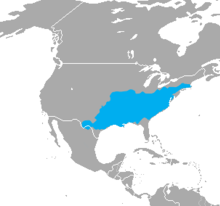Agkistrodon contortrix
Agkistrodon contortrix is a species of venomous snake. The common name for this species is the eastern copperhead.[2] It lives mainly on the eastern coast of North America and in the Mississippi drainage. They're common. Compared to others they're more likely to bite if they feel threatened. They're medium-sized. One of the longest ones ever recorded measuring a little more than four feet long. The copperhead is venomous, but its venom is rarely fatal to humans.
| Agkistrodon contortrix | |
|---|---|

| |
| Scientific classification | |
| Domain: | Eukaryota |
| Kingdom: | Animalia |
| Phylum: | Chordata |
| Class: | Reptilia |
| Order: | Squamata |
| Suborder: | Serpentes |
| Family: | Viperidae |
| Genus: | Agkistrodon |
| Species: | A. contortrix
|
| Binomial name | |
| Agkistrodon contortrix (Linnaeus, 1766)
| |

| |
| Synonyms | |
| |
Description
changeCopperhead snakes have reddish-brown bodies with a crossband pattern consisting of tan and copper. The average length adult copperheads is 76 cm in length. and are normally described as heavy-bodied snakes. Copperheads are sexually dimorphic. The head has a solid, rich brown color. Copperhead venom is usually not fatal to healthy adult humans. They can live up to 18 years.[3]
Distribution and Habitat
changeIt is found in North America. In the United States, it is found in Alabama, Arkansas, Connecticut, Delaware, Northern Florida, Georgia, Illinois, Indiana, Iowa, Kansas, Kentucky, Louisiana, Maryland, Massachusetts, Mississippi, Missouri, Nebraska, New Jersey, New York, North Carolina, Ohio, Oklahoma, Pennsylvania, South Carolina, Tennessee, Texas, Virginia and West Virginia. In Mexico, it is found in Chihuahua and Coahuila.[4]
It lives in many different types of habitats. In most of North America, it likes deciduous forest and mixed woodlands. During the winter, it hibernates in caves or in cracks in limestone. It is also found in coniferous forest. It is also found in the Chihuahuan Desert of West Texas and northern Mexico.[5][6]
Diet and predators
changeThe copperhead eats mainly rodents, especially mice. Sometimes it eats birds, other reptiles, even snakes, and amphibians. They also feed on some insects, a lot of times cicadas, because of their size that'll fill a copperhead up. They eat other animals, but they're not the apex predator around their habitat, Their natural predators include kingsnakes, water moccasins (also known as cottonmouths), bullfrogs, large birds of prey, coyotes, alligators, and an other predators.
Behaviour
changeThe copperhead snake is active from March or April to early November in the northern part of its range. During the winter, they have been seen to basking on warm days in December and January. Even though copperheads have been seen hibernating by themselves they usually hibernate together.
Copperheads are mainly active during the day in the spring and autumn. In the summer months, they become nocturnal to hunt during the evening.[3]
Reproduction
changeThe copperhead snake breeds in late summer, but not every year. They give birth to their young ones alive. They usually give birth to four to seven young ones. The young ones are lighter in color, and with a yellowish-green-marked tip to the tail, which is used to lure lizards and frogs.[7]
Venom
changeEven though copperhead snakes are venomous, bites are almost never fatal. The symptoms of a bite from a copperhead snake is extreme pain, tingling, throbbing, swelling, and severe nausea.
The venom of the southern copperhead has been found to hold a protein called "contortrostatin" It stops the growth of cancer cells in mice and also stops the tumors from moving to other places in the body. However, further testing is needed to make sure that it is safe and efficient in humans.
The antivenom CroFab is used to treat copperhead bites that show symptoms. It is not given when there is no symptoms.
References
change- ↑ Frost DR; Hammerson GA; Santos-Barrera G (2007). "Agkistrodon contortrix". IUCN Red List of Threatened Species. 2007. Retrieved 2017-05-20.
- ↑ Moriarty, John J. 2017. Scientific and standard English names of amphibians and reptiles of North America north of Mexico with comments regarding confidence in our understanding. 8th ed. Society Study Amphibians and Reptles Herpetological Circular 43: 102 pp.
- ↑ 3.0 3.1 Hartsuff, Anna. "Agkistrodon contortrix (Southern Copperhead)". Animal Diversity Web. Retrieved 2020-09-16.
- ↑ McDiarmid, Roy W. (1999). Snake species of the world : a taxonomic and geographic reference. Campbell, Jonathan A., Touré, TŚhaka A., Herpetologists' League. Washington, DC: Herpetologists' League. ISBN 1-893777-01-4. OCLC 42256497.
- ↑ "Northern copperhead". Smithsonian's National Zoo. 2016-04-25. Retrieved 2020-09-16.
- ↑ Campbell, Jonathan A. (2004). The venomous reptiles of the Western Hemisphere. Lamar, William W., 1950-. Ithaca: Comstock Pub. Associates. ISBN 0-8014-4141-2. OCLC 52047308.
- ↑ Smith, C. F.; Schwenk, K.; Earley, R. L.; Schuett, G. W. (2008). "Sexual size dimorphism of the tongue in a North American pitviper". Journal of Zoology. 274 (4): 367–374. doi:10.1111/j.1469-7998.2007.00396.x. ISSN 0952-8369.[permanent dead link]
